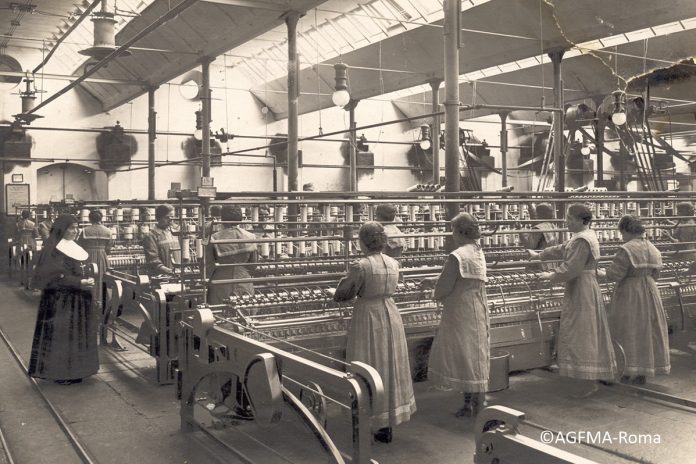Rome (Italy). On 1 May 2023, Labor Day is celebrated in many countries around the world. On the same day in 1955, on the occasion of the tenth anniversary of the foundation of the Catholic Association of Italian Workers (ACLI), Pius XII declared Saint Joseph patron saint of craftsmen and workers, establishing the Feast on that day “so that the humble craftsman of Nazareth not only impersonates the dignity of the worker before God and the Holy Church, but he is also always your provident guardian and of your families.” (Discourse of Pope Pius XII on the occasion of the solemnity of St. Joseph Worker – 1 May 1955).
Attention to the world of work has been a priority in the educational action of St. John Bosco, St. Mary Mazzarello, and all those who are inspired by them. “Don Bosco conceives the school as a function of society and its transformation, convinced that education is a factor of social change, one of the most ordinary ways to remedy the social ills of the time” (Piera Cavaglià, Education and culture of the woman, “Our Lady of Grace” school in Nizza Monferrato from its origins to the Gentile Reform (1878 – 1923), LAS Rome 1990, p. 42).
In Mary Mazzarello’s life, work is the daily context in which to live one’s personal and original vocation. She learns to sew with Petronilla from the village tailor with the aim of being able to open a workshop in which to welcome, accompany, educate, and form girls. The House of the Immaculata was conceived as an environment of integral education and professional training, as we would say today.
Also at the College, the first FMA understood the school as a place where the girls experienced themselves and discovered talents through the lessons and activities proposed. In Salesian education, education and job training are inseparable, given that they aim at the “good Christian and honest citizen”. Of course, in those times, the majority of girls would have taken care of the family, but the preparation received would have made them responsible and capable of initiative.
At the beginning of the 20th century, with the equalization of “Our Lady of Grace” School in Nizza Monferrato and the possibility of forming teachers, the educational experience of the FMA opened up to new frontiers. The teachers will be agents of a silent but effective transformation of the social fabric.
Mother Caterina Daghero, called to succeed the Co-foundress in the government of the Institute, agreed that the FMA would dedicate themselves to the management of resident schools for workers employed in factories. In 1897, she agreed to send some Sisters to direct the female workers’ resident school of Cannero in the province of Verbano Cusio Ossola. She told the Sisters that it was a work “new in form, not in substance. Indeed, it was an ancient work, she explained with a smile, because it was aimed precisely at that part of the people, at that portion of souls that Don Bosco wanted to save. He had gathered poor children of the people and had made them honest craftsmen, good Christians. They had to do the same with those dear daughters who were in such need of religious instruction, of maternal vigilance, of affection. For this reason, a Sister (Sister Clelia Guglielminotti) was sent as Animator. She belonged to an industrial family, intelligent, with a big heart, and expert of the field in which she went to manage and to work” (Giuseppina Mainetti, Mother Catherine Daghero, SEI Turin, p. 232).
In 1917, the Institute’s statistics indicated 14 works of this kind, of which 7 in Italy and the same number abroad. The educators were present in the workplace “in order to assist employees and workers, to make them love work and fulfill their duty with serenity” (Grazia Loparco, The Daughters of Mary Help of Christians in Italian society (1900-1922). Pathways and problems of research, Las Roma 2002, p. 638).
Naturally, the FMA in accepting these works had agreed on accords that guaranteed them the realization of the educational purpose of the Institute. Therefore, they supervised the girls’ relationships with employers and other workers, their living and working conditions. They offered educational possibilities, including participation in and preparation for the Sacraments. In some cases, the Sisters and the girls shared the work activity. In the biography of Mother Catherine Daghero, we read that she loved this work, valued its purpose, and encouraged the Sisters to be assiduous and active, according to the style of the Preventive System.
With Mother Daghero, it can be said that the FMA not only educated to work, but educated at work, committing themselves to making it a meaningful and not a degrading experience as it often was.
Today as then, work often constitutes a denied right, a reason for suffering, a place of exploitation. Pope Francis recalls, “Not enough account is taken of the fact that work is an essential component in human life, and also in the path of sanctification. Working not only serves to obtain the right livelihood, it is also a place where we express ourselves, we feel useful, and we learn the great lesson of concreteness, which helps the spiritual life not to become spiritualism. Unfortunately, however, work is often hostage to social injustice and, rather than being a means of humanization, it becomes an existential periphery” (Pope Francis, General Audience, Wednesday, 12 January 2022).
Only education and evangelization will be able to humanize work, modifying its laws and conditions, restoring it to its deepest essence: human expression of God’s creative action. For this reason, the Daughters of Mary Help of Christians join in the desire expressed by Pope Francis in a tweet dated 1 May 2021: “The work of St. Joseph reminds us that God Himself made man did not disdain to work. Let us implore St. Joseph the Worker so that we can find ways that commit us to saying: no young person, no person, no family without work!”.




















